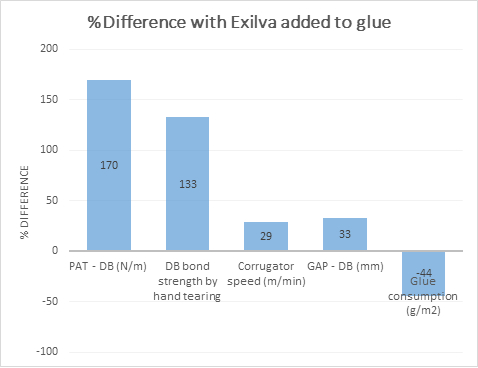
The secret to stronger corrugated boards
Synnøve Holtan | September 21, 2021
The bonding quality determines the ultimate strength of the corrugated board. In my previous blog post I revealed increased speed results for the production of corrugated boards. In this blog post I have investigated what effect Exilva Microfibrillated Cellulose (MFC) has on bond strength.
Make sure you don't miss out on the corrugated series.
Synnøve's other posts can be found here:
- A way to reach prolonged stability of starch adhesives
- Bring your corrugated starch adhesive robustness to a new level with Exilva MFC
- Boost your corrugator productivity with Exilva microfibrillated cellulose
Adhesive's role in board manufacturing
The adhesive plays an essential role for corrugated boards manufacturing and quality of the final converted product. As demonstrated in previous posts, the highly entangled network of Exilva cellulose fibrils enables a strong interaction by multiple hydrogen bonds with both starch and cellulose molecules of the paper. Upon shearing between the doctor and application rolls, Exilva improves the flow of the starch adhesive for accurate transfer onto the flute tips, important for an efficient bonding of the the paper surfaces. In process, the cellulose fibrils act as a reinforcement mesh, bringing elasticity and robustness of the adhesive bond towards mechanical impacts, reducing delamination.
The effect of Exilva on the adhesion and bond strength was demonstrated in a factory trial. B-flute quality corrugated boards with paper combination 115EK/100WF/115EK (g/m2) / 24EK/20WF/24EK (lbs/1000 ft2 (msf)) were produced on a combined BHS/Fosber corrugator of 2.8 meters width by using a Stein-Hall native wheat adhesive without, or with Exilva. The bond strength of the fluted medium to the Double Backer (DB) liner in N/m was measured by Pin Adhesion Test (PAT), according to the Fefco no. 11 standard, after curing and conditioning under controlled temperature and humidity (23°C, 50RH%, ISO 187). Moreover, the initial bond strength of the semi-cured corrugated boards was measured during manufacturing by hand tearing by a person skilled in the art, grading the strength according to a scale where 1 was the lowest and 4 was the highest. The results are shown in the figure below.

By adding Exilva to the adhesive, an increase of 170% in bond strength for the Double Backer was found, compared to the reference adhesive. The glue with Exilva also gave significantly higher initial or semi-cured bond strength, evaluated by hand tearing of the boards. The improved texture and glue ability resulted in an increase in production speed for the quality of 29%, and a reduction in glue consumption of 44%, measured as the difference in grammage according to ISO 536.
What about the warp?
The application of Exilva to the starch glue has shown to improve the adhesion and corrugated boards quality. The better bonding with Exilva, allows for less waste from delamination issues, but what about the warp related waste? Will the reduction in applied glue amount, and thus water, applied to the papers, have an effect on warp? The outcome of Exilva on the warp issue in manufacturing of corrugated boards is the theme of my next blog post in this corrugated boards series.
Make sure you are subscribed to our newsletter so that you never miss out on an update from the Exilva blog.
Are you curious to learn more about Exilva? Contact us to run a trial, you can get your free sample here, or click the button below for a talk with one of our corrugated experts:
Written by:
Synnøve Holtan
Synnøve Holtan has worked with microfibrillated cellulose MFC since 2005 and has developed an in-depth understanding of the product characteristics, as well as production processes and application innovation. As a senior scientist at Borregaard she focuses on the analyses and performance of Exilva in industrial applications, such as coatings and adhesives. Synnøve has a PhD in biopolymer chemistry from the Norwegian University of Science and Technology.
